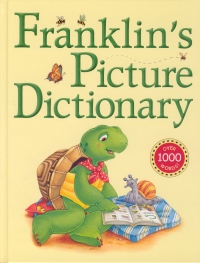| ________________
CM . . .
. Volume XI Number 12 . . . .February 18, 2005
Designed for children in kindergarten to grade 3 and described as a "language-learning resource," Franklin's Picture Dictionary consists of three principal parts. The first, and by far the largest portion, is the A-Z picture dictionary. The second section deals with "Concept Words" while the concluding 10 or so pages suggest language activities that can be utilized by the adult who is sharing this book with a child. In the book's dictionary portion, the entire alphabet is repeated across the top of each pair of facing pages with the focal letter highlighted. The picture dictionary utilizes a two-column format for each page so that entry words are read top to bottom. The number of words for each letter of the alphabet varies greatly with "B" having 45 words, followed by "S" with 39 words and "C" and "P" with 33. "A", "D," "E," "F," "G," "H," "L," "O," "T" and "W" have from 21-27 words. At the low end is "X" with but two words and "I," "Q," "U," "V," "Y" and "Z" with just three words. Each letter is initially presented both in upper and lower case, and then a sentence is used which utilizes the letter several times, usually as the initial letter of a word:
Each word being "defined" in a letter section is accompanied by an illustration from a Franklin book and an explanative sentence. Consequently, the picture of a "quilt" has with it the sentence "The quilt from Bear's bed is freshly washed." When a word can have variants, those variations are listed as well:
Occasionally the illustrative sentences are presented in an interrogative form to encourage discussion between the adult and child users of the book.
The book's concept section begins with the numbers from one to twenty with the objects to be counted being things that Franklin, as a turtle, might eat: "nine wooly bear caterpillars" or "eighteen asparagus beetles." Numbers are followed by the days of the week, beginning with Monday and presented via a journal in which Franklin briefly records what he does each day. The months of the year follow with an illustration that reflects some aspect of the month: May finds Franklin's family saying, "Happy Mother's Day!" while September means "Back to school!" A single page deals with the four seasons via Franklin's classmates' seasonal artwork which decorates the classroom bulletin board. An unusual concept is "Parts of a Turtle," a labeled picture of Franklin which invites readers to compare/contrast their body parts with those of Franklin. The concluding two pages of this section consist of two pages of graded sets of "Words I Can Read," words for readers at the Preschool, Kindergarten, Grade One and Grade Two levels. Not all of the words in these lists are found in Franklin's Picture Dictionary, with those that are being printed in green. Hopefully, adult users of this book will have first scanned the Table of Contents or heeded the "Note to adults" on page 5, both of which will direct them to page 102 where they will receive guidance on "How to Use This Book." This concluding portion of the book also contains "Suggested Activities" of varying levels of difficulty for both younger and more experienced readers. The connection of Franklin's Picture Dictionary to the popular book and TV character will be a strong motivating factor in a child's (and likely also the parent's) decision to spend time with the book's contents. An obvious home purchase, Franklin's Picture Dictionary should also be in library collections serving preschoolers and early years students. Recommended. Dave Jenkinson teaches courses in children's and adolescent literature in the Faculty of Education, the University of Manitoba.
To comment
on this title or this review, send mail to cm@umanitoba.ca.
Copyright © the Manitoba Library Association. Reproduction for personal
use is permitted only if this copyright notice is maintained. Any
other reproduction is prohibited without permission.
NEXT REVIEW |
TABLE OF CONTENTS FOR THIS ISSUE
- February 18, 2005.
AUTHORS |
TITLES |
MEDIA REVIEWS |
PROFILES |
BACK ISSUES |
SEARCH |
CMARCHIVE |
HOME |

 Four criteria were utilized in selecting the words to be included in Franklin's Picture Dictionary. The words had to be: common words in the English language; high-frequency words; words encountered in Franklin storybooks; and words whose meanings can be effectively conveyed through illustrations. Regarding the last criterion, obviously, the dictionary is most successful in pictorially defining a word when that word is a noun or a verb. Adverbs and sometimes adjectives pose larger challenges. For example, again is accompanied by the sentences, "Bear's tummy I always rumbling. Look, he's having a snack again!" In this instance, there is a temporal aspect to the word "again," something that cannot be appropriately conveyed by a single, fixed-in-time illustration. The adjective "eager" demands action to convey its meaning, something which again cannot be adequately portrayed by a static illustration: "Franklin is eager to go on a class trip to the museum."
Four criteria were utilized in selecting the words to be included in Franklin's Picture Dictionary. The words had to be: common words in the English language; high-frequency words; words encountered in Franklin storybooks; and words whose meanings can be effectively conveyed through illustrations. Regarding the last criterion, obviously, the dictionary is most successful in pictorially defining a word when that word is a noun or a verb. Adverbs and sometimes adjectives pose larger challenges. For example, again is accompanied by the sentences, "Bear's tummy I always rumbling. Look, he's having a snack again!" In this instance, there is a temporal aspect to the word "again," something that cannot be appropriately conveyed by a single, fixed-in-time illustration. The adjective "eager" demands action to convey its meaning, something which again cannot be adequately portrayed by a static illustration: "Franklin is eager to go on a class trip to the museum."